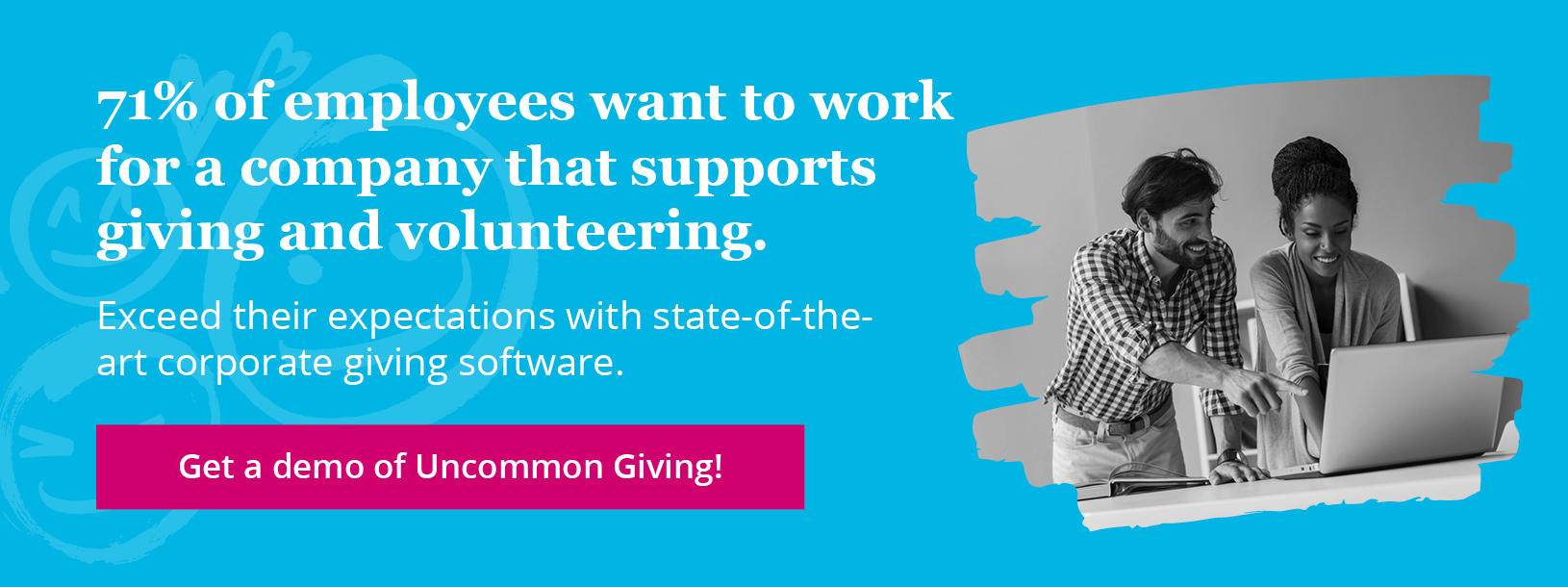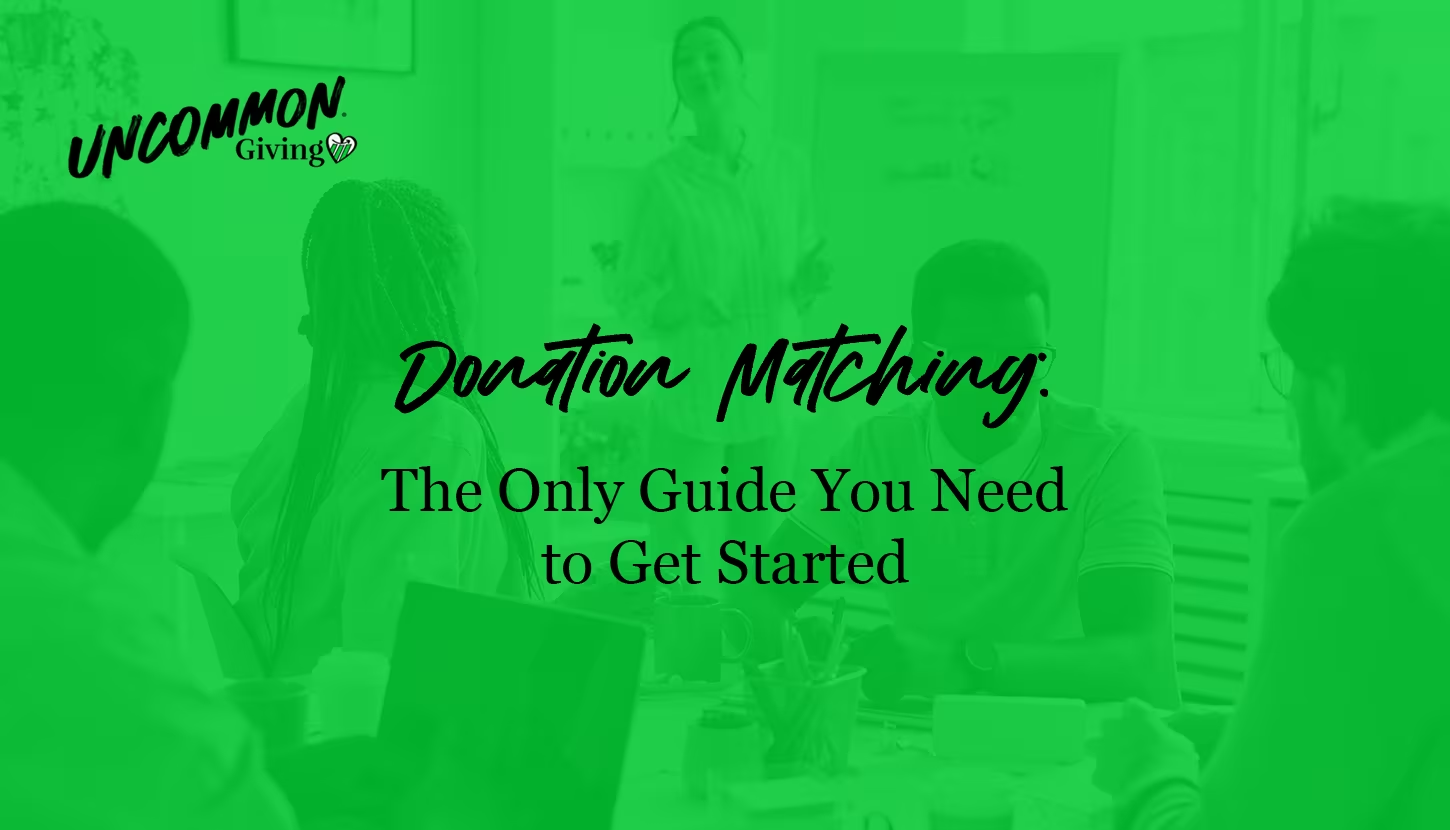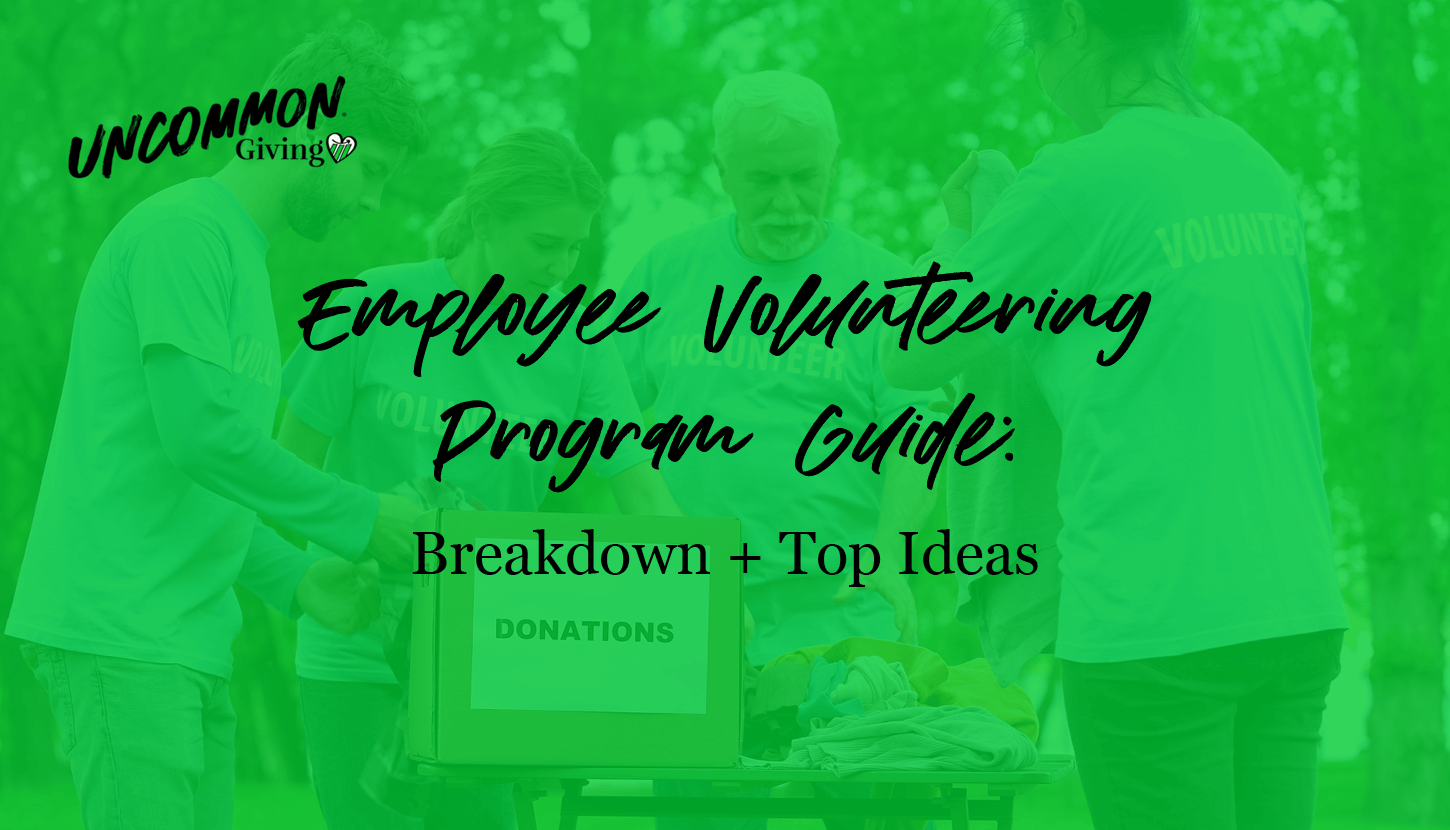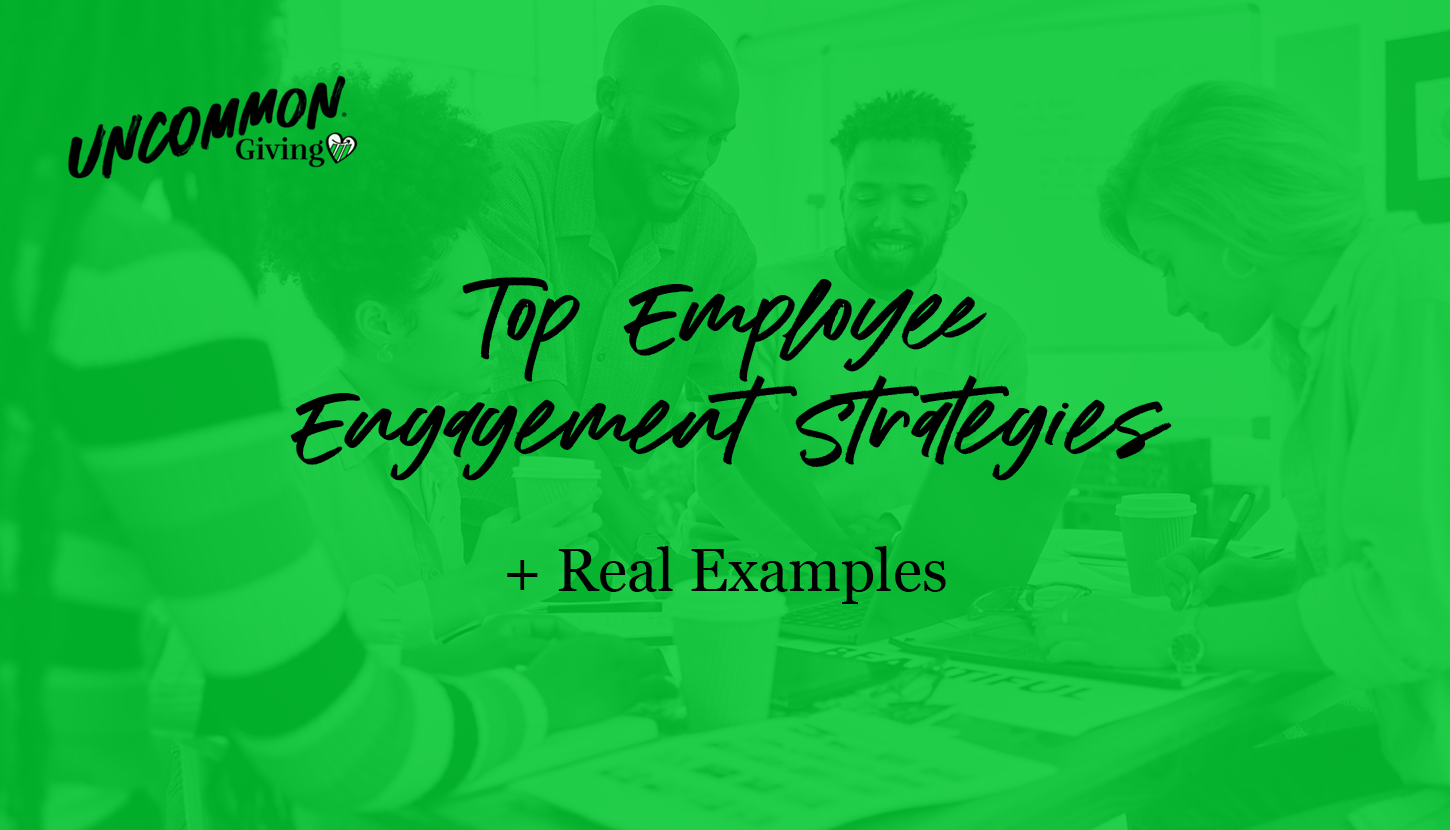In the past year, 4.3 billion people (73% of the world’s adult population) gave their time or money or helped someone they didn’t know. Whether they’re driven by concerns about social inequality, healthcare, or climate change, many people want to take action and make a difference in the world. This action often takes the form of donations, with 69% of Americans regularly giving to nonprofits.
Workplace giving initiatives, such as donation matching, allow companies and individuals to team up and generate more impact together. In this guide, we’ll cover everything you need to know to become an expert on donation matching programs, including:
- What Does Donation Matching Mean?
- What Are the Benefits of Matching Donations?
- How to Start a Donation Matching Program
- Strong Examples of Corporate Gift Matching
With 76% of U.S. adults pointing to the nation’s future as a significant source of stress in their lives, workplace giving programs are becoming more relevant than ever as a means of driving social change. While there are various types of these programs, matching donations is often the most common place to start.

What Does Donation Matching Mean?
Donation matching is a corporate giving initiative in which a company matches the donations their employees make to charitable causes. Generally, the process involves these basic steps:
- An individual donates to a nonprofit.
- The individual checks their eligibility for a matching donation from their employer.
- The eligible employee submits a gift matching request.
- The employer reviews and approves the match request.
- The company makes its own donation to the nonprofit, typically at a dollar-for-dollar amount.
For example, if an employee gives $100 to a nonprofit, their employer would match the contribution with another $100 donation, which means the nonprofit receives $200 in total.
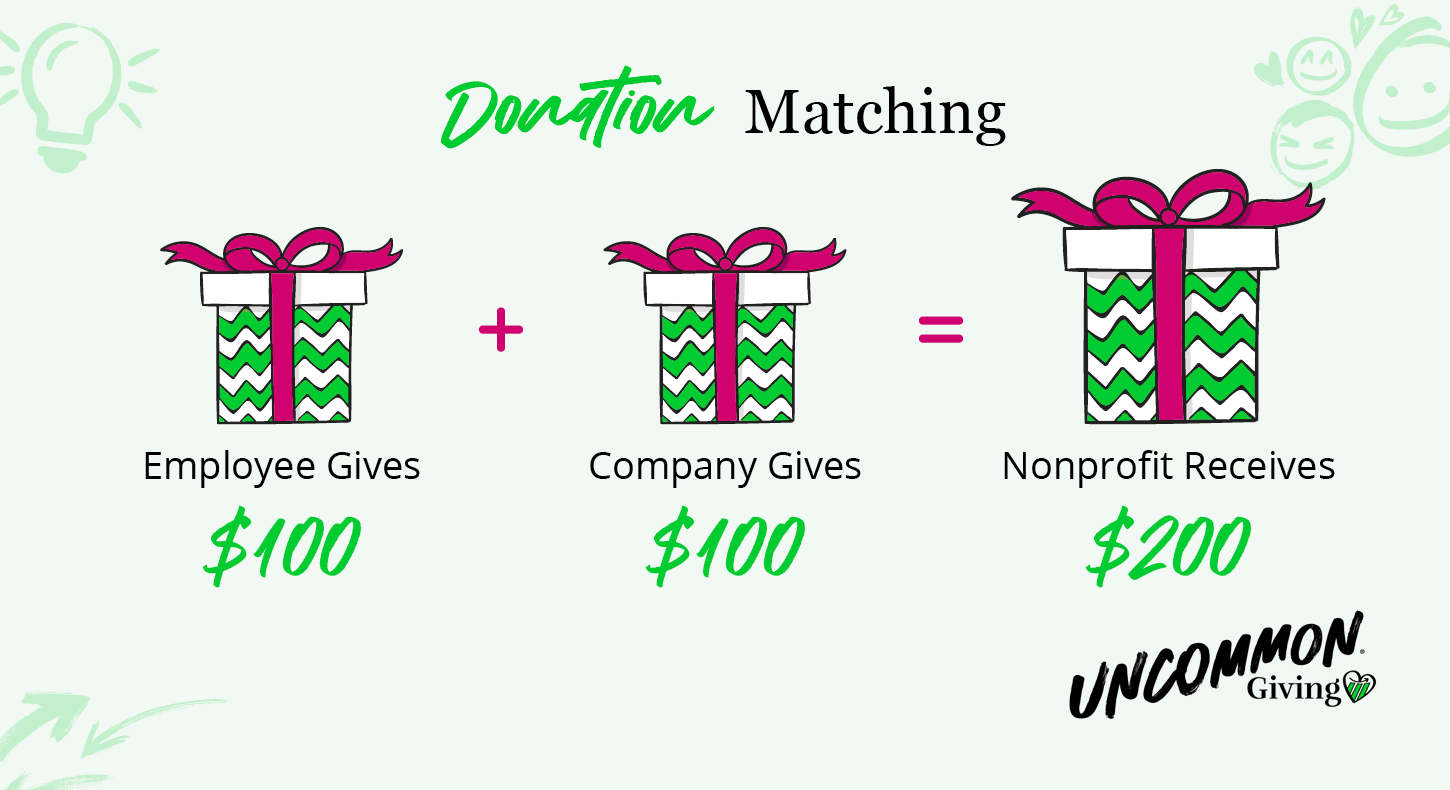
What Are the Benefits of Matching Donations?
The popularity of donation matching programs stems from the extensive benefits they bring to companies, nonprofits, individuals, and society as a whole:
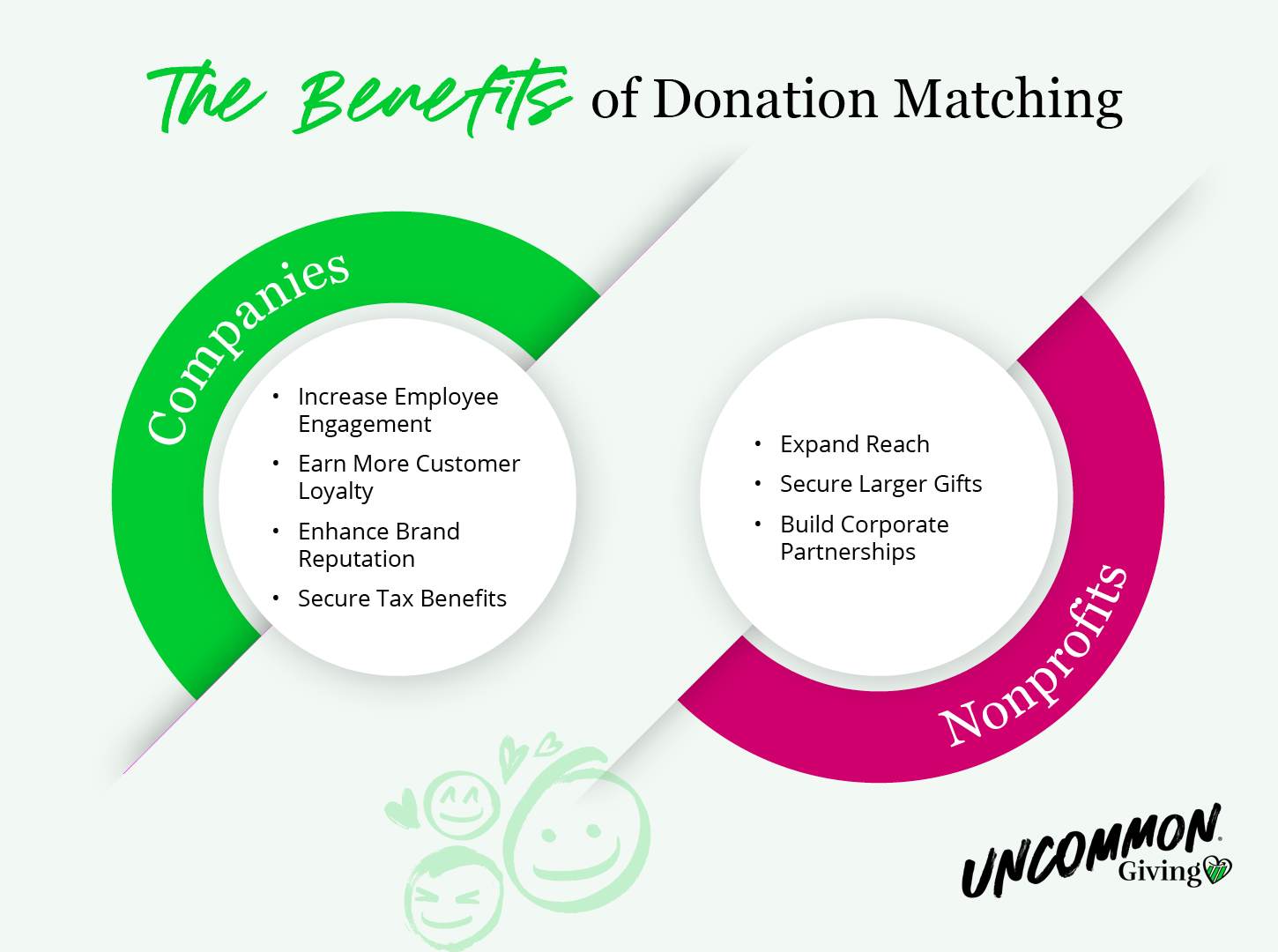
How Companies Benefit
Many companies include donation matching in their corporate social responsibility (CSR) strategy to demonstrate that they’re committed to improving the communities in which they operate—rather than purely making a profit. In doing so, they:
- Increase employee engagement. 87% of employees believe businesses should take a public position on societal issues relevant to their industry. Employees want to know that their company stands behind their needs and values. By matching donations to causes they care about, companies can recruit and retain talented employees for the long term.
- Earn more customer loyalty. Many factors lead people to switch brands, from price to customer service quality. Recent research reveals that 82% of shoppers want a brand’s values to align with their own, with 75% reporting that they’ve stopped supporting a brand due to conflicting values. Companies with a donation matching program stand out in the eyes of socially conscious consumers, ultimately earning their long-term loyalty.
- Enhance brand reputation. Over three-quarters of Americans believe that companies can be a powerful force of societal change. A gift matching program is an easy way to fulfill this expectation, reinforcing a company’s reputation as an innovative, socially responsible member of society.
- Secure tax benefits. According to the IRS, donations to 501(c)(3) nonprofit organizations are tax-deductible, which means companies can reduce their taxable income when they donate.
In turn, employees can make their dollars go further without giving away more of their hard-earned money. They’re much more likely to feel fulfilled in their roles when they know their employment comes with opportunities to make an impact on society.
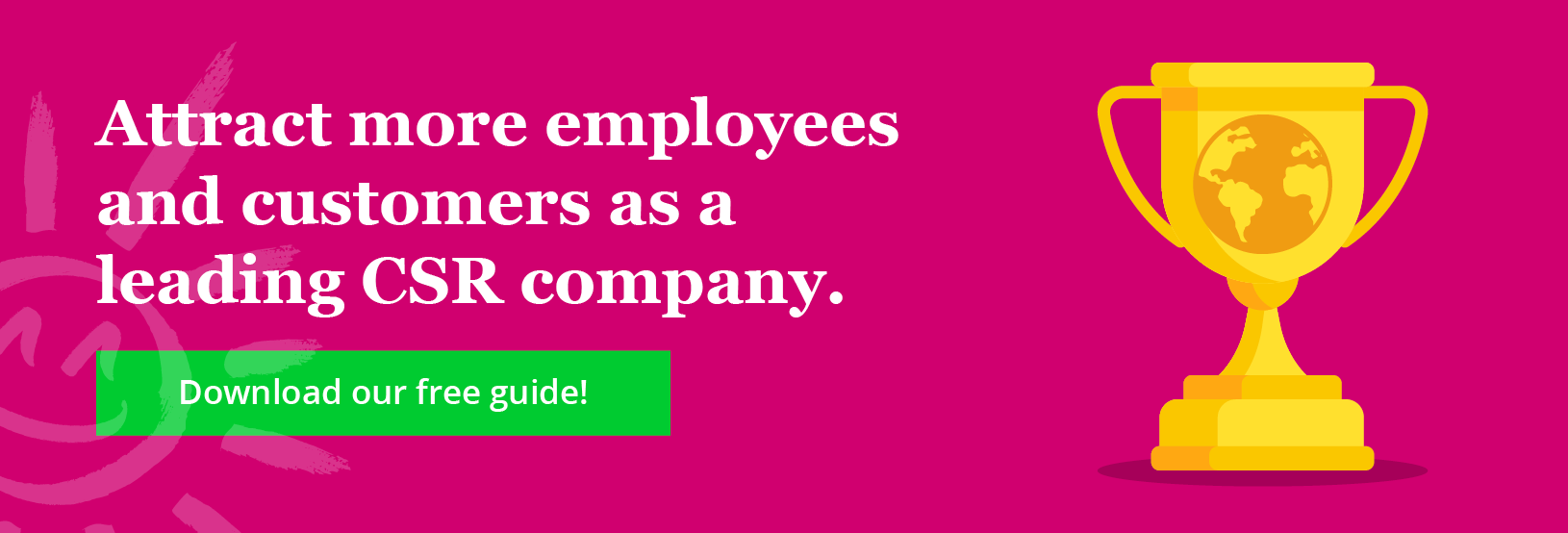
How Nonprofits Benefit
Beyond providing more funding for their cause, donation matching programs allow nonprofits to:
- Expand reach. By promoting gift matching opportunities across their marketing channels, nonprofits can catch the attention of more potential donors. The chance to double the impact of their donation might be the extra push needed to motivate someone who was on the fence about giving.
- Secure larger gifts. When donors have the opportunity to make their dollars go twice as far, they’re likely to give more to take advantage of the expanded impact. In fact, according to Double the Donation, one in three donors say they would contribute a larger donation if they knew it would be matched and doubled by their employer.
- Build corporate partnerships. When several employees at a company care about a certain nonprofit, that company is much more likely to extend other types of support to that organization, from sponsoring events to providing pro bono services. Establishing these long-term, mutually beneficial partnerships can generate more reliable contributions and resources over time.
With an estimated $2-$3 billion donated through matching gift programs annually, nonprofits can tap into a significant funding source simply by promoting these programs to their donor base.
How to Start a Donation Matching Program
When starting from scratch, companies must consider their specific goals and employee preferences to set their donation matching programs up for maximum engagement and impact. Follow these steps to outline and launch a program that’s built for lasting success:
1. Invest in corporate giving software.
The gift matching process has many moving parts. Your company must verify employee eligibility, evaluate requests, track donations, and monitor its overall impact. To facilitate these tasks, consider corporate giving software options that fit your budget and needs.
The top corporate giving solutions will make it easy to:
- Allow employees to donate to nonprofits directly through the platform.
- Create a streamlined matching gift request form for employees to submit.
- Automatically approve or deny requests based on predefined criteria.
- Track employee donations alongside matching contributions.
- Distribute funds to designated nonprofits on a recurring basis.
- Access real-time reports on participation, donations, and impact.
Bonus tip: Look for platforms that are Certified Leaders in Matching Automation (CMLA-certified), such as Uncommon Giving. The CLMA certificate is given to platforms that provide the industry’s most accessible and streamlined gift matching experience for employees and the nonprofits they support.
For example, CMLA-certified platforms provide auto-submission capabilities to employees. With auto-submission, your company’s employees do not have to fill out a donation matching request form manually. Instead, all they have to do is input their company email address, and the rest of the request is automatically completed on their behalf.

2. Create guidelines for matching donations.
Each company will have its own way of managing and monitoring its donation matching program. To maintain consistency and transparency, outline all the details upfront in an official employee-facing document.
Include these essential elements in your guidelines:
- Matching gift ratio: Companies typically match donations at a 1:1 ratio, which means an employee’s $50 donation will earn a $50 match from their employer. However, depending on your budget, you can go lower (0.5:1) or higher (2:1 or 3:1).
- Minimum and maximum match amounts: Decide on the minimum and maximum donation amounts that your company will match. The average minimum match amount among companies is $34, while the average maximum match is $3,728.
- Employee eligibility: Will your company only match donations made by full-time employees, or will you allow part-time employees to participate? Some programs even extend eligibility to retired employees and employee spouses.
- Donation eligibility: Your company might go beyond matching traditional donations made by their employees. For example, you could apply donation matching to automatic payroll deductions or match stock donations by contributing the value of the stock on the day it was transferred to the nonprofit.
- Nonprofit eligibility: Many companies require nonprofits to be verified 501(c)(3) organizations to be eligible for gift matching. Some exclude religious or political causes. Depending on your company’s purpose, you might specify that you’ll only support nonprofits with certain missions, such as educational institutions or health organizations.
- Submission deadlines: Set a clear deadline for submitting match requests, such as six or 12 months after the donation date. To simplify the process, some companies set their deadline for the end of the calendar year in which the donation was made or the end of their fiscal year.
Additionally, consider how your company will disburse matching funds to nonprofits. Many companies have a monthly distribution schedule, for example. If multiple employees submit matching gift requests to the same organization, decide whether you’ll combine your matches into a single donation or a separate donation per employee.
3. Promote your donation matching program to employees.
To maximize employee participation in your giving programs, your company must first make them aware of these opportunities. Beyond providing your gift matching guidelines in an accessible location, such as your employee handbook and portal, promote the program via:
- A company-wide meeting or kick-off event.
- A dedicated page on your website with a program overview and FAQs.
- Email newsletters that highlight the benefits and steps involved.
- Social media posts spotlighting employee participants.
- Flyers and brochures in the office and break rooms.
To further incentivize employees to get involved, identify a nonprofit many of them are interested in supporting. Then, reach out to establish a partnership and create a custom matching gift program for that organization. If your typical match ratio is 1:1, you might match donations to this nonprofit partner at a 2:1 or even 3:1 ratio.
Or, designate specific days throughout the year during which you’ll increase your match ratio. For example, Omatic Software inspires employee participation in its streamlined donation matching program by offering increased matches on special corporate giving days, such as Giving Tuesday. Many employees who may have been considering donating to a nonprofit will jump at the opportunity to do so on a day with increased impact.
4. Measure and improve your results.
Matching donations can transform your workplace culture for the better, but any successful initiative takes time and improvement. Track metrics such as employee participation, number of donations matched, total match amount, and average donation size to assess your donation matching program’s performance over time.
From there, brainstorm improvements to boost employee engagement and amplify your program’s impact. For instance, you could:
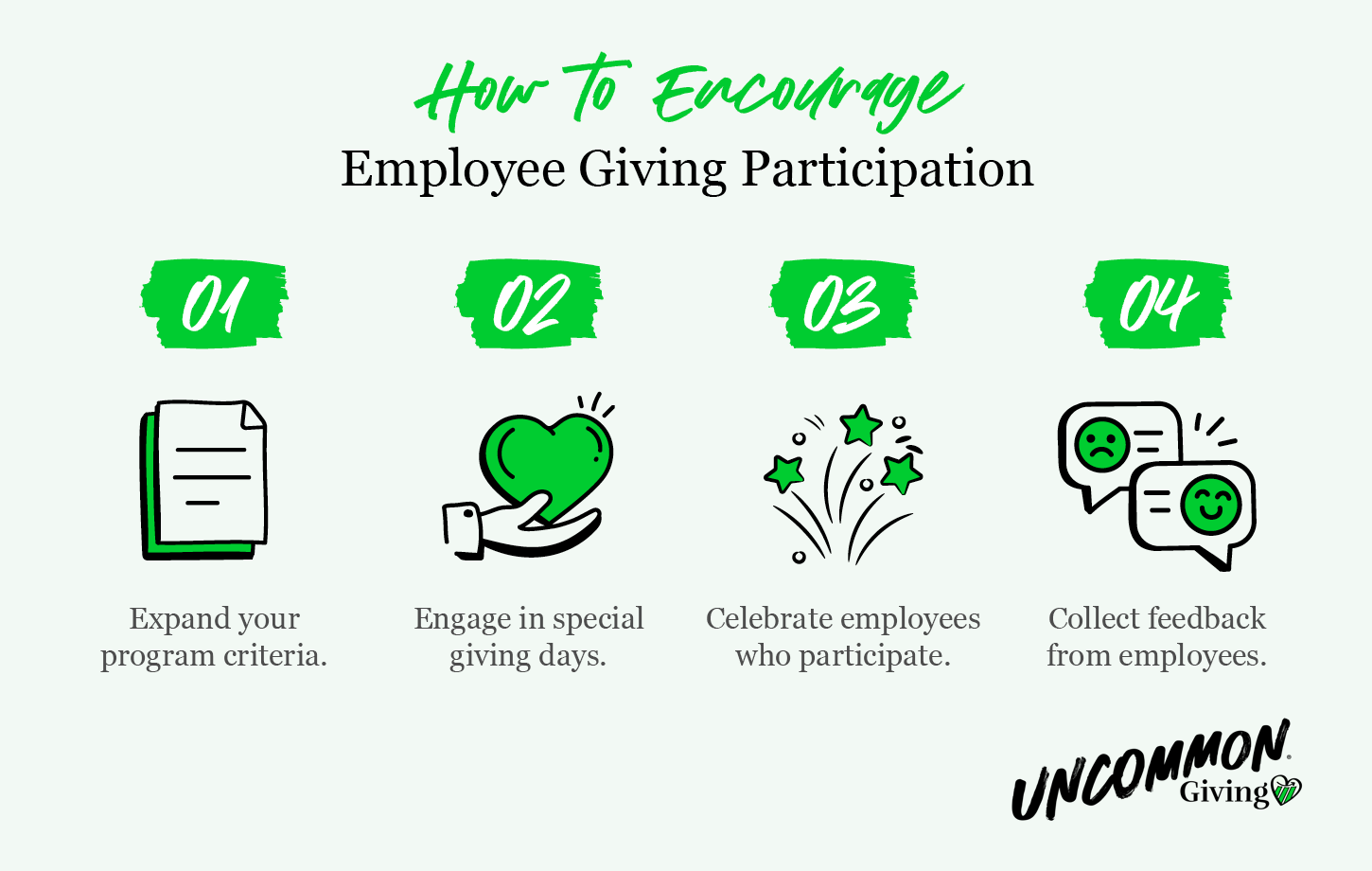
- Expand your program criteria. If not as many employees are participating as you’d like, consider lowering your minimum match amount so it’s easier for them to donate amounts that fit their budget. Or, extend eligibility to your part-time and retired employees.
- Engage in special giving days. Depending on your company’s purpose or employee interests, consider increasing your matching ratio on special cause awareness or giving days. For example, a medical devices manufacturing company might increase donation matches on World Health Day in April and International Nurses Day in May, while a publishing company might do so on World Poetry Day in March and International Literacy Day in September.
- Celebrate employees who participate. Reinforce participation by recognizing employees who get involved. You can send animated eCards, spotlight key contributors on social media, or even invite these employees to an annual, exclusive event where they can mingle with their colleagues and learn about the impact of their donations.
- Collect feedback from employees. Tailor your donation matching program to employees’ needs and expectations by sending an annual or bi-annual survey to gather their input. Ask employees what would motivate them to participate, which causes they are most interested in supporting, and whether they have any suggestions for improving your program.
Be patient as you refine your gift matching program over time, and be upfront about the changes you decide to make. Transparency is key when managing your corporate giving programs and reporting on impact to stakeholders, from employees to customers.
Strong Examples of Corporate Gift Matching
Companies of all sizes can launch and maintain a successful corporate gift matching program. Explore how these leading businesses approach donation matching to set your own program up for success:
Vertex Pharmaceuticals
As a biopharmaceutical company dedicated to researching medicines for serious diseases, Vertex empowers its employees to make an impact through its matching gift program. The company structures its program as follows:
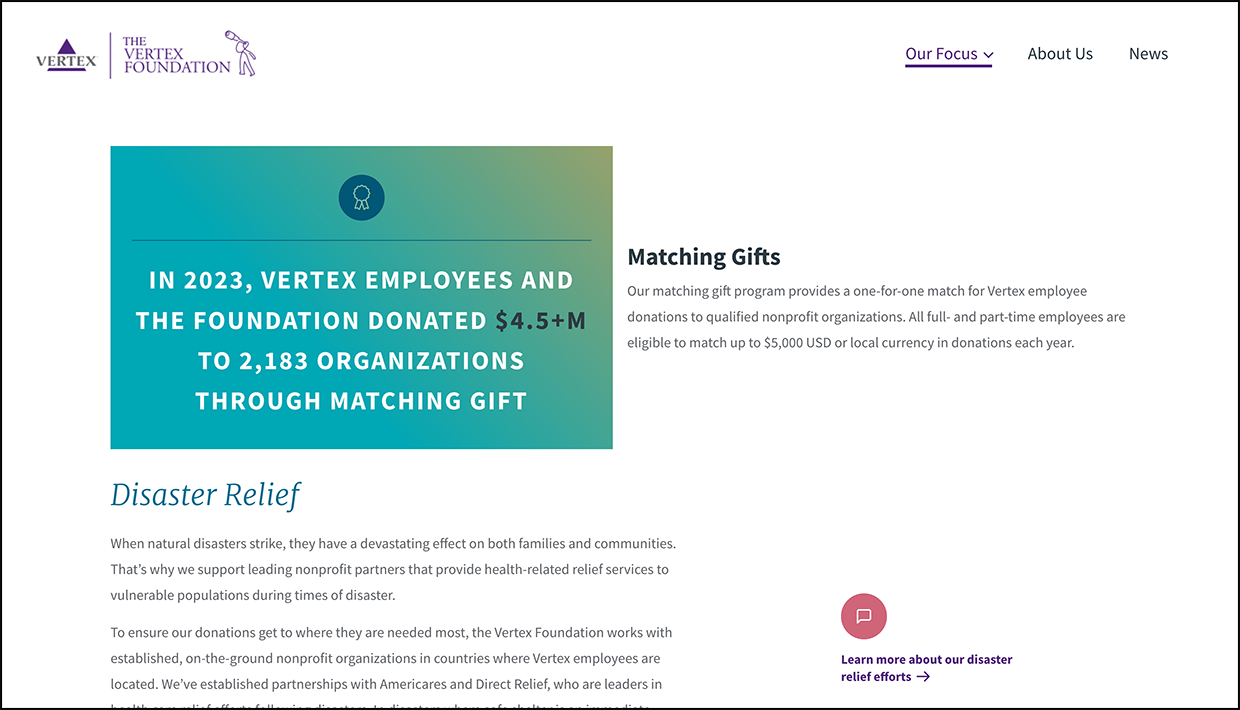
- 1:1 match ratio
- All full- and part-time employees are eligible
- $5,000 match amount per employee each year
In a single year, Vertex and its employees contributed nearly $4.5 million to 2,183 nonprofits worldwide. Additionally, the company has an annual Day of Service, during which it encourages employees to sign up for a wide range of team volunteering opportunities to give back to their community.
Mission Wealth
Every year, Mission Wealth donates a percentage of its wealth management firm profits to around 150 nonprofits worldwide. Beyond that, the company allows individual employees to make an impact through its donation matching program, offering up to $2,000 in matches per year.
The company’s main charitable focus areas are environmental protection, health and human services, youth and education, and financial literacy. Since Mission Wealth has offices located across the country, it provides team volunteering events and philanthropic budgets for each area. Its volunteer time off (VTO) policy makes it easy for employees to contribute their time and energy to nonprofits without sacrificing their hard-earned free time.
RingCentral
RingCentral, a cloud-based communication company, focuses its CSR strategy on environmental impact, social initiatives, and governance practices. Through its 1:1 donation matching program, the company and its employees have contributed over $1.42 million to charitable causes in the community. In some circumstances throughout the year, employees can even take advantage of double matching and no-limit matching opportunities.
In addition to matching donations, RingCentral allows its employees to provide product discounts and donations to registered nonprofits. Plus, when employees volunteer a certain number of hours with an eligible organization, the company donates to that organization as part of its Dollars for Doers program.
Wrapping Up: Taking Your Impact Beyond Matching Donations
Starting a donation matching program opens the door for increased engagement and impact for your company—but you don’t have to stop there. As your program expands and thrives, explore additional initiatives such as Dollars for Doers, payroll deductions, and company-wide volunteering events. With a comprehensive workplace giving platform like Uncommon Giving, you’ll have all the tools to manage and streamline these opportunities right at your fingertips.
Before long, your company will be able to establish itself as a leader in philanthropy and employee engagement in its sector.
If you’d like to learn more about workplace giving programs and the tools for facilitating them, check out these additional resources:
- What Is Workplace Giving? 5 Steps to Boost Engagement. Explore the ins and outs of workplace giving and how your company can develop programs employees can’t wait to participate in.
- 11+ Best CSR Software for Impact, Engagement, and ROI. Discover the industry-leading software solutions that will help your company stand out as a CSR leader.
- 12 Top Corporate Volunteering Platforms for Making an Impact. Want to engage your employees in volunteering? Find the right tools to support your efforts.
